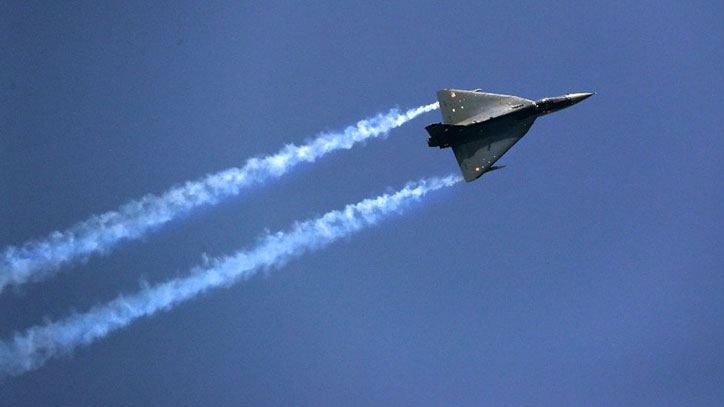 New Delhi:
New Delhi: The peremptory rejection of the shipborne variant of the Tejas light combat aircraft (LCA) by the Indian Navy seems to have surprised most navy-watching analysts. Their confusion has been compounded by the near-simultaneous issuance of a global request for information (RFI) for procurement of "57 multirole fighters for its aircraft carriers" by Naval HQ.
One can deduce two compelling reasons for this, seemingly, radical volte face by the only service which has shown unswerving commitment to indigenisation (lately labelled 'Make in India') for the past six decades.
Firstly, by exercising a foreclosure option, the navy has administered a well-deserved and stinging rebuke to the Defence Research and Development Organisation (DRDO) for its lethargic and inept performance that has again disappointed our military. The second reason arises from the navy's desperate hurry to freeze the specifications of its second indigenous aircraft carrier (IAC-2). The choice of configuration, size and propulsion of a carrier has a direct linkage with the type of aircraft that will operate from it. This constitutes a "chicken and egg" conundrum -- should one freeze the carrier design first or choose the aircraft first? The Indian Navy has obviously decided the latter.
The IAC-2 will enter service in the next decade, at a juncture where a balance-of-power struggle is likely to be underway in this part of the world -- with China and India as the main players. It is only a matter of time before China's carrier task-forces, led by the ex-Russian carrier Liaoning and her successors, follow its nuclear submarines into the Indian Ocean. Since the Indian response to such intimidation will need to be equally robust, the decisions relating to the design and capabilities of IAC-2 (and sisters) assume strategic dimensions. Essentially, there are three options for selection of aircraft for the IAC-2.
* Conventional take-off and landing types like the US F/A-18 Super Hornet and French Rafale-M that would require a steam catapult for launch and arrester-wires for recovery. The relatively large ship would need either a steam or nuclear plant for propulsion.
* Types like the Russian Sukhoi-33 and MiG-29K would require only a ski-jump for take-off and arrester-wires for landing. This would mean a smaller ship, driven either by gas turbines or diesel engines. The LCA (Navy) could have been a contender in this category.
* The F-35B Lightning II version of the US Joint Strike Fighter, capable of vectored-thrust, would require only a ski-jump for take-off, but no arrester wires since it can land vertically. This would result in the simplest and cheapest ship; a short take-off and vertical landing (STOVL) carrier.
Once the navy has selected an aircraft, the ship and its operating and maintenance facilities can be designed around it, avoiding some of the pitfalls encountered on IAC-1.
Reverting to the LCA saga - as far back as the early 1990s, the navy had initiated a study for examining the feasibility of adapting the LCA to shipborne use. While confirming feasibility, the study had revealed some major problem areas, which included lack of engine thrust, requirement of an arrester hook and stronger undercarriage, and need for cockpit/fuselage re-design before the LCA could attempt carrier operations. Undaunted, the navy re-affirmed its faith in the programme by contributing over Rs 400 crore as well as engineers and test pilots to the project.
The IAF accepted the Tejas into service, in July 2016, with considerable reservations because it had not been cleared for full operational exploitation and fell short of many qualitative requirements. The prototype LCA (Navy) had rolled out six years earlier, in July 2010, raising great hopes. However, it is obvious that the DRDO failed to address the problems listed above with any urgency, leading to ultimate rejection of this ambitious project.
By its failure to deliver on the LCA (Navy), the DRDO has let down its most steadfast supporter amongst the armed forces -- the Indian Navy. A little introspection by those at the helm of this organisation would reveal to them three reasons for its abysmal performance despite a wealth of talent and a network of sophisticated laboratories -- an exaggerated opinion of their capabilities; a lack of intellectual honesty in denying obvious failures and an unwillingness to seek external help when required.
Today, India has the ignominious distinction of being the world's biggest importer of military hardware, whereas China counts amongst the world's leading arms exporters and its aeronautical establishment has delivered aircraft ranging from UAVs to 5th generation fighters, helicopters and transports to the PLA.
While one would be justified in blaming the scientists and bureaucrats responsible for defence research and production, the root cause of this colossal failure lies in political indifference and the inability to provide vision and firm guidance to our massive but under-performing military-industrial complex.
# Admiral Arun Prakash (Retd) is a former chief of the Indian Navy. The article is in special arrangement with South Asia Monitor/www.southasiamonitor.org
 New Delhi: The peremptory rejection of the shipborne variant of the Tejas light combat aircraft (LCA) by the Indian Navy seems to have surprised most navy-watching analysts. Their confusion has been compounded by the near-simultaneous issuance of a global request for information (RFI) for procurement of "57 multirole fighters for its aircraft carriers" by Naval HQ.
New Delhi: The peremptory rejection of the shipborne variant of the Tejas light combat aircraft (LCA) by the Indian Navy seems to have surprised most navy-watching analysts. Their confusion has been compounded by the near-simultaneous issuance of a global request for information (RFI) for procurement of "57 multirole fighters for its aircraft carriers" by Naval HQ.